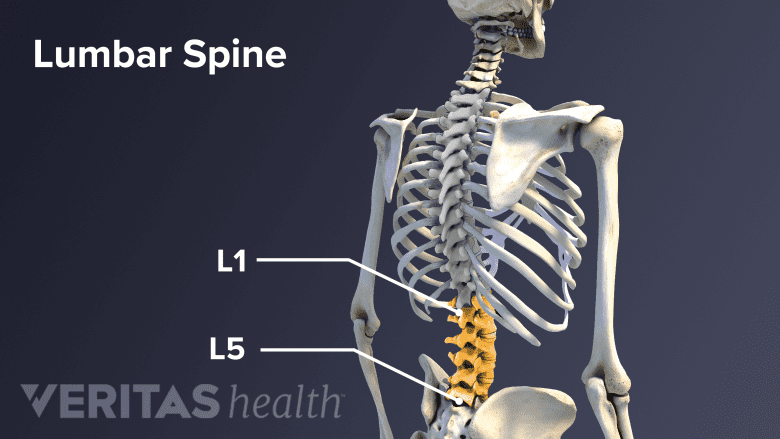The lower back comprises the lumbar spine, which is formed by vertebral bones, intervertebral discs, nerves, muscles, ligaments, and blood vessels. The spinal cord ends at the top of the lumbar spine, and the remaining nerve roots, called the cauda equina, descend down the remainder of the spinal canal.
While the lumbar spine is sturdy and resilient, it is subject to a high degree of stress and loads, which may cause various problems, resulting in pain.
In This Article:
Functions of the Lumbar Spine
The lower back plays a critical role in both lower and upper body movements.
The lower back performs the following important functions:
- Support and stabilize the upper body. The 5 lumbar vertebrae are the largest compared to other spinal regions.1 ,2 In conjunction with the muscles and ligaments, these vertebrae help support the weight of the upper body, including the head and neck. The lumbar spine also transfers loads from the upper body to the legs.2
- Allow truncal movements. The lower back is the primary facilitator for movements of the trunk in various directions, including front and back, side to side, and twisting movements.3 Movement mostly occurs in the last two vertebral levels.4
- Protect the spinal cord and cauda equina. The upper lumbar vertebrae protect the spinal cord in their vertebral arches. The lower vertebrae provide a bony enclosure for the cauda equina nerves that descend from the spinal cord.
- Control leg movements. The lumbar spinal nerves that branch off from the spinal cord and cauda equina to control movements and sensation in the legs.
When viewed from the side, the lumbar spine has a concave lordotic curve that helps distribute weights and reduce the concentration of stresses. An increase or decrease in this lordosis may contribute to lower back pain.2
Lumbar Spinal Motion Segment
A single lumbar motion segment.
The normal anatomy, as well as potential problems in the lumbar spine, are better understood by focusing on a spinal motion segment.
Read more about Spinal Anatomy and Back Pain
A single lumbar motion segment is comprised of:
- Two consecutive vertebrae, such as L4-L5, stacked vertically.
- An intervertebral disc that has a soft inner gelatinous core surrounded by a tough fibrous covering is situated between the vertebrae. The disc acts like a shock absorber in the spine, allowing flexibility and providing protection from jarring movements.
- Two facet joints that allow bending and twisting movements in the lower back.
- Two spinal nerves that branch off from the spinal cord or cauda equina. These spinal nerves pass through small holes in between consecutive vertebrae and travel down the rear pelvis and legs.
The structures in a motion segment are held together by a network of ligaments, muscles, and tendons. Doctors typically name the motion segments while referring to lower back disorders, such as L4-L5 disc degeneration.
The lumbar spine connects with the thoracic spine above at the thoracolumbar junction and the sacral spine below at the lumbosacral joint. The lumbar motion segments may be affected by congenital (birth-related), degenerative, traumatic, or inflammatory disorders.







